![]()
![]()
![]()
Use LEFT and RIGHT arrow keys to navigate between flashcards;
Use UP and DOWN arrow keys to flip the card;
H to show hint;
A reads text to speech;
63 Cards in this Set
- Front
- Back
|
CNS divisions
|
brain and spinal cord
|
|
|
PNS divisions
|
motor neurones, sensory neurones,, somatic nervous system, autonomic nervous system, sympathetic division parasympathetic division
|
|
|
autonomic vs somatic nervous systems
|
somatic- Consists of spinal and cranial nerves connected to skeletal muscles and skin receptors. These enable us to feel changes we can control
Autonomic Consists of cranial nerves connected to non-skeletal muscles and glands. These nerves control functions that control breathing heartbeat and organ functions: things we cannot control |
|
|
how does the ANS operate
|
via reflex arcs
|
|
|
what is white matter made of
|
axons with myelin sheaths
|
|
|
gray matter is made out of
|
axons without mylein sheaths
|
|
|
brain reflex centre
|
medulla oblangata
|
|
|
somatic nervous system
|
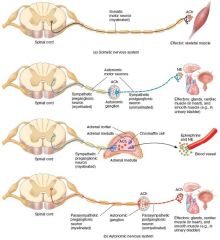
has pre and post ganlion neurones
ganglions release acetyle choline or adrenaline to inhibit or excite responses |
|
|
what are the 2 types of autonomic ganglia
|
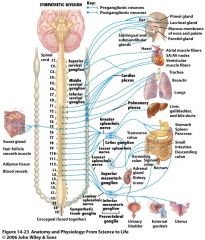
sympathetic trunk ganglia and ganglia prevertebral ganglia
|
|

how many preganglionic cell bodies are there in the nuclei of cranial nerves
|
4
|
|
|
to maintain homeostasis the nervous system must be....
|
capable of detecting change or stimuli
|
|
|
what carries out specialised cells carry out detection
|
sensory neurones called receptors
|
|
|
in most effector organs what is the response cased by ?
|
neurotransmitter
|
|
|
congenital analgesia
|
Children with this condition often suffer oral cavity damage or fractures to bones. Unnoticed infections and corneal damage are also seen.
Because the child cannot feel pain, they may not respond to problems, thus being at a higher risk of more severe diseases There are some cases where the condition is caused by increased production of endorphins, in which case naloxone may be used as treatment. This treatment does not always work. In some cases, this disorder can be in the voltage gated-sodium channel. Patients with such mutations are congenitally insensitive to pain and lack other neuropathies. |
|
|
what is sensation
|
– conscious or subconscious detection of external or internal stimuli
|
|
|
what part of the brain is reposnible for conscious thought
|
cerebral cortex
lower brain stem |
|
|
what is perception
|
– conscious awareness and interpretation of sensations
|
|
|
what area is responsible for perception
|
cerebral cortex
|
|
|
how many sensory neurons carry information for to a modality
|
1
|
|
|
how many sensory receptors respond to one kind of stimulus e.g hearing
|
1
|
|
|
somatic senses
|
– tactile (touch, pressure, vibration)
– thermal (warm and cold) – pain – proprioception (moving, nonmoving, limb position) |
|
|
visceral
|
– conditions within internal organs by ANS
|
|
|
Sense Organs
|
-Sense organs enable awareness of conditions or events in the internal or external environment
-The stimuli or the sensations are detected by special sensory cells called receptors, generating impulses. -Sensory neurons relay this information about the stimulus to the CNS = interpretation, integration & perception -Motor neurons relay the CNS command to relevant effector organs where a response occurs. |
|
|
process of sensation
|
1. Stimulation of sensory receptor (specialised cell or dendrites of sensory neurone) selectivity
• must occur within receptive field 2. Transduction of stimulus • transduce = convert energy in a stimulus to a graded potential 3. Generation of impulses • when graded potential reaches threshold • triggers action potential/s toward CNS 4. Integration of sensory input • occurs in cerebral cortex |
|
|
sensory receptors classification
|
1.The first order sensory neurons are in the dorsal root ganglia or the sensory ganglia of cranial nerves.
2. The second order sensory neurons are in the dorsal gray column or various sensory nuclei of the brainstem. 3. The third order sensory neurons are in the thalamic nuclei. EXAMPLE: Typically, the perception of pain travels through three orders of neurons. The first-order neurons carry signals from the periphery to the spinal cord; the second-order neurons relay this information from the spinal cord to the thalamus; and the third-order neurons transmit the information from the thalamus to the primary sensory cortex, where the information is processed, resulting in the "feeling" of pain. ` . |
|
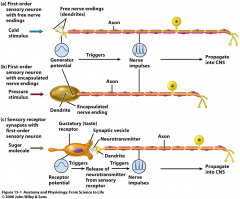
microscopic structure of nerve
|
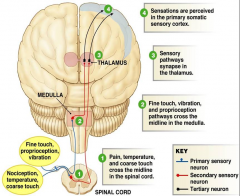
1.free nerve endings of first order sensory neurones (e.g. Pain & temperature)
2.encapsulated nerve endings of first order sensory neurones (Pacinian corpuscles for touch) 3.Separate cells that synapse with first order sensory neurones (hair cells, gustatory receptor cells, photoreceptors) |
|
|
what graded potentials do sensory receptors produce
|
generated potentials
receptor |
|
|
what is a generator potential
|
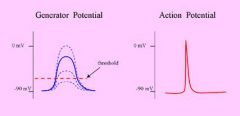
A generator potential is a graded response to a stimulus and if it becomes large enough it produces an action potential. These generator potentials "add" together which is called summation and allows an action potential to fire.
|
|
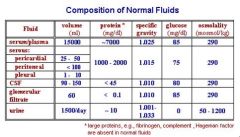
what is an action potential
|
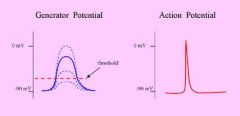
An action potential is not graded and is all or nothing. Also an action potential travels along a nerve fibre where as a generator potential does not it is localised change is the concentration of charges
|
|
|
what are exteroreceptors
|
sensory receptor located near or at body surface. provide info about external environment e.g 5 senses and pain, pressure
|
|
|
interoreceptors
|
sensory receptors in blood vessels and visceral organs, nervous system. they provide info on internal environment
|
|
|
what are proprioreceptors
|
they are sensory receptors in the muscles tendons joints and inner ear and they provide info on body position and motion joints and balance
|
|
|
what is the function of mechanoreceptors
|
they detect deformation of adjacent cells and provide sensations for touch pressure hearing, bp, stretching
|
|
|
thermoreceptors
|
change in temp
|
|
|
nocireceptors
|
respond to stimuli resulting from physical or chemical damage to tissue
|
|
|
photoreceptors
|
detect light that strikes retina
|
|
|
chemoreceptors
|
detects chemicals in mouth taste, smell and body fluids
|
|
|
osmoreceptors
|
sense osmotic pressure of body fluids
|
|
|
Adaptation in Sensory Receptors
|
Generator or receptor potential decreases in amplitude during a maintained constant stimulus
frequency of nerve impulses in first-order neuron decreases perception of sensation may fade or disappear even though stimulus persists receptors vary in how quickly they adapt |
|
|
what are rapidly adapting receptors
|
phasic e.g touch
|
|
|
slowly adapting receptors
|
tonic- temperatures
|
|
|
what is somatic sensation
|
Stimulation of sensory receptors in skin or subcutaneous layer, mucous membranes, tendons, muscles
|
|
|
somatic sensation
|
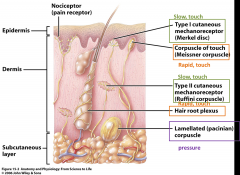
|
|
|
phantom limb
|
After amputation may still experience itching, pressure or pain
Severed endings of sensory axons are still present If activated the cerebral cortex interprets the sensation as coming from sensory receptors in the phantom limb Area of cerebral cortex undergoes extensive functional reorganisation to respond to stimuli from other body parts Gives rise to false sensory perception |
|
|
Somatic sensory pathways
|
Relay information from the somatic sensory receptors to the primary somatosensory area in the cerebral cortex
The pathways are made of thousands of sets of 3 neurones First order neurones: conduct impulses from the somatic receptors into the brain (via cranial or spinal nerves) Second order neurones: conduct impulses from the brain stem & spinal cord to the thalamus. Axons decussate here Third order neurones: conduct impulses from the thalamus to the primary somatosensory area of the cortex |
|
|
what are regions in the CNS where neurones synapse are called
|
relay station
|
|
|
where do neurones of many sensory pathways synapse ?
|
in the thalamus, spinal cord & brain stem (they are all relay stations)
|
|
|
Somatic sensory impulses ascend the cerebral cortex via 3 pathways which are ?
|
-Posterior column-medial lemniscus pathway
-Anterolateral (spinothalamic) pathway -Trigeminothalamic pathway |
|
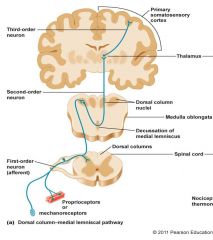
Posterior column-medial lemniscus pathway
|
is the sensory pathway responsible for transmitting fine touch, vibration and conscious proprioceptive information from the body to the cerebral cortex;[1] as well as tactile pressure, barognosis, graphesthesia, stereognosis, recognition of texture, kinesthesia and two-point discrimination.[2]
The name comes from the two structures that the sensation travels up: the posterior (or dorsal) columns of the spinal cord, and the medial lemniscus in the brainstem. |
|
|
posterior column pathway
|
1st order neurones extend from sensory receptors into spinal cord & ascend to the medulla oblongata
Cell bodies are in the posterior (dorsal) root ganglia Their axons form the posterior column Synapse with 2nd order neurone in medulla Axons cross to opposite side & enter medial lemniscus |
|
|
spinothalamic tract
|
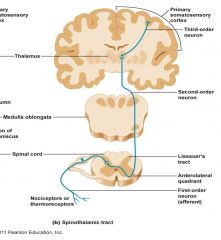
The spinothalamic tract is a sensory pathway originating in the spinal cord.
t transmits information to the thalamus about pain, temperature, itch and crude touch. The pathway decussates at the level of the spinal cord, rather than in the brainstem like the posterior column-medial lemniscus pathway and corticospinal tract. |
|
|
posterior column pathway
|

|
|
|
anterolateral pathway
|

|
|
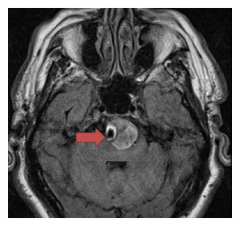
Wallenberg syndrome
|
Lateral medullary syndrome (also called Wallenberg syndrome) is a disease in which the patient has a constellation of neurologic symptoms
characterised by sensory deficits affecting the trunk (torso) and extremities on the opposite side of the infarction and sensory deficits affecting the face and cranial nerves on the same side with the infarct. Specifically, there is a loss of pain and temperature sensation on the contralateral (opposite) side of the body and ipsilateral (same) side of the face. |
|
|
syphilis
|
Caused by Treponema pallidum.
If left untreated progresses to tertiary stage: debilitating neurological problems Degeneration of posterior portions of spinal column Somatic sensations are lost, the persons gait becomes jerky as impulses fail to reach the cerebellum |
|
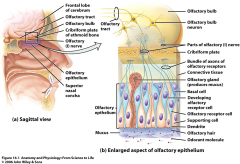
Olfactory receptors
|
Recognise about 10 000 different odours
Nose contains 10 million to 100 million receptors for the sense of smell in the olfactory epithelium olfactory epithelium consists of olfactory receptors, supporting cells and basal cells |
|
|
Olfactory epithelium
|
Supporting cells: columnar epithelial of mucous membrane lining the nose
Physical support, nourishment, electrical insulation, detoxification Basal cells: stem cells. Olfactory receptors live for 1 month (they are neurones, which tend not to be replaced) |
|
|
Odour thresholds and adaptations
|
low threshold
Eg methyly mercaptan 1/25billionth of a mg/ml Adaptation (decreasing sensitivity) occurs rapidly- about 50% in the first second |
|
|
asomnia
|
inability to detect odors
|
|
|
hyposmia
|
- Decreased ability to detect odours
|
|
|
parosmia
|
Altered perception of smell in the presence of an odour, usually unpleasant
|
|
|
phantosmia
|
perception of smell without ordour present
|
|
|
Agnosia
|
Inability to classify or contrast odours, although able to detect odours
|

